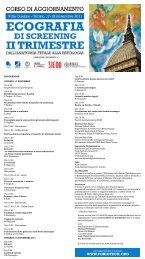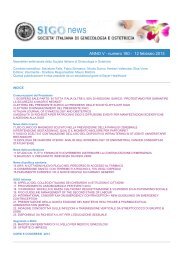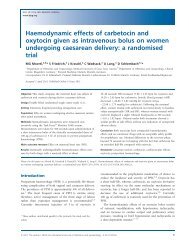Effects of ibuprofen, diclofenac, naproxen, and piroxicam on ... - Sigo
Effects of ibuprofen, diclofenac, naproxen, and piroxicam on ... - Sigo
Effects of ibuprofen, diclofenac, naproxen, and piroxicam on ... - Sigo
You also want an ePaper? Increase the reach of your titles
YUMPU automatically turns print PDFs into web optimized ePapers that Google loves.
Safety <str<strong>on</strong>g>of</str<strong>on</strong>g> individual NSAIDs during pregnancy<br />
studies. Informati<strong>on</strong> <strong>on</strong> outcome variables was obtained<br />
mainly from MBRN records. All diagnoses from the MBRN<br />
records are based <strong>on</strong> the Internati<strong>on</strong>al Classificati<strong>on</strong> <str<strong>on</strong>g>of</str<strong>on</strong>g> Diseases,<br />
10th revisi<strong>on</strong> (ICD–10). 31 The chosen outcomes from<br />
the MBRN were infant survival (live birth), any c<strong>on</strong>genital<br />
malformati<strong>on</strong>s, major c<strong>on</strong>genital malformati<strong>on</strong>s, patent<br />
ductus arteriosus, birthweight < 2500 g, gestati<strong>on</strong>al<br />
age < 37 weeks, Apgar score < 7 at 5 minutes, ne<strong>on</strong>atal<br />
respiratory depressi<strong>on</strong>, intracranial haemorrhage, intraventricular<br />
haemorrhage, vaginal bleeding during pregnancy<br />
(including bleeding during the first, sec<strong>on</strong>d, <str<strong>on</strong>g>and</str<strong>on</strong>g>/or third trimesters),<br />
<str<strong>on</strong>g>and</str<strong>on</strong>g> postpartum haemorrhage > 500 ml.<br />
Two pregnancy outcomes, namely structural heart defect<br />
<str<strong>on</strong>g>and</str<strong>on</strong>g> asthma symptoms, were based up<strong>on</strong> the mother’s<br />
recordings in the fourth questi<strong>on</strong>naire at 18 m<strong>on</strong>ths after<br />
delivery, where she was specifically asked whether the child<br />
has been diagnosed with a c<strong>on</strong>genital cardiac defect or had<br />
been referred to a specialist for asthma investigati<strong>on</strong>. The<br />
outcome variables were dichotomised into ‘yes or no’ categories.<br />
Figure 1. The study populati<strong>on</strong>. Q1: Questi<strong>on</strong>naire distributed at<br />
gestati<strong>on</strong>al week 17. Q2: Questi<strong>on</strong>naire distributed at gestati<strong>on</strong>al<br />
week 30.<br />
gestati<strong>on</strong>al week 30 until birth). When two or more medicati<strong>on</strong>s<br />
were reported for <strong>on</strong>e indicati<strong>on</strong>, with several timings<br />
crossed out, we assumed that the medicati<strong>on</strong>s had<br />
been used during all <str<strong>on</strong>g>of</str<strong>on</strong>g> the time periods specified. No data<br />
<strong>on</strong> dosage were available. Data <strong>on</strong> the durati<strong>on</strong> <str<strong>on</strong>g>of</str<strong>on</strong>g> treatment<br />
were incomplete, <str<strong>on</strong>g>and</str<strong>on</strong>g> were therefore not used. Drug<br />
exposure was classified according to the Anatomical Therapeutic<br />
Classificati<strong>on</strong> (ATC) system. 30 We defined NSAID<br />
exposure as exposure to a drug bel<strong>on</strong>ging to the ATC code<br />
M01AE01 for ibupr<str<strong>on</strong>g>of</str<strong>on</strong>g>en, M01AB05 for dicl<str<strong>on</strong>g>of</str<strong>on</strong>g>enac,<br />
M01AE02 for <str<strong>on</strong>g>naproxen</str<strong>on</strong>g>, <str<strong>on</strong>g>and</str<strong>on</strong>g> M01AC01 for <str<strong>on</strong>g>piroxicam</str<strong>on</strong>g>.<br />
The effect <str<strong>on</strong>g>of</str<strong>on</strong>g> each <str<strong>on</strong>g>of</str<strong>on</strong>g> the four individual NSAIDs <strong>on</strong> the<br />
course <str<strong>on</strong>g>of</str<strong>on</strong>g> pregnancy <str<strong>on</strong>g>and</str<strong>on</strong>g> pregnancy outcome was analysed<br />
according to the timing <str<strong>on</strong>g>of</str<strong>on</strong>g> therapy:<br />
1 ‘use during pregnancy (total)’ (yes/no);<br />
2 ‘use during the first trimester (gestati<strong>on</strong>al weeks 1–12)’<br />
(yes/no);<br />
3 ‘use during the sec<strong>on</strong>d trimester (gestati<strong>on</strong>al weeks 13–<br />
28)’ (yes/no); <str<strong>on</strong>g>and</str<strong>on</strong>g><br />
4 ‘use during the third trimester (gestati<strong>on</strong>al week 29 until<br />
delivery)’ (yes/no).<br />
Outcome variables<br />
The choice <str<strong>on</strong>g>of</str<strong>on</strong>g> outcome variables was based <strong>on</strong> the current<br />
knowledge <str<strong>on</strong>g>of</str<strong>on</strong>g> NSAID pharmacology <str<strong>on</strong>g>and</str<strong>on</strong>g> results from prior<br />
Potential c<strong>on</strong>founding factors<br />
The c<strong>on</strong>founding factors that we adjusted for are listed in<br />
Appendix S1. These included socio-demographic, lifestyle,<br />
<str<strong>on</strong>g>and</str<strong>on</strong>g> medical characteristics, c<strong>on</strong>comitant drug use (this<br />
informati<strong>on</strong> was derived from the questi<strong>on</strong>naires <str<strong>on</strong>g>of</str<strong>on</strong>g> The<br />
Norwegian Mother <str<strong>on</strong>g>and</str<strong>on</strong>g> Child Cohort Study), factors<br />
related to delivery (this informati<strong>on</strong> was derived from the<br />
MBRN), <str<strong>on</strong>g>and</str<strong>on</strong>g> lifestyle factors <str<strong>on</strong>g>and</str<strong>on</strong>g> medical characteristics<br />
postpartum (this informati<strong>on</strong> was derived from the questi<strong>on</strong>naires<br />
<str<strong>on</strong>g>of</str<strong>on</strong>g> The Norwegian Mother <str<strong>on</strong>g>and</str<strong>on</strong>g> Child Cohort<br />
Study).<br />
Statistical analysis<br />
Significant associati<strong>on</strong>s between each <str<strong>on</strong>g>of</str<strong>on</strong>g> the four individual<br />
NSAIDs <str<strong>on</strong>g>and</str<strong>on</strong>g> pregnancy complicati<strong>on</strong>s <str<strong>on</strong>g>and</str<strong>on</strong>g> outcome were<br />
measured using logistic regressi<strong>on</strong>. Risk ratio estimates are<br />
given as adjusted odds ratios (ORs) with 95% c<strong>on</strong>fidence<br />
intervals (95% CIs). For ORs significant at the 5% level,<br />
99% CIs are also presented because <str<strong>on</strong>g>of</str<strong>on</strong>g> the large number <str<strong>on</strong>g>of</str<strong>on</strong>g><br />
comparis<strong>on</strong>s made. The following analysis strategy was used.<br />
1 Chi-square tests were used to assess the relati<strong>on</strong>ships<br />
between explanatory <str<strong>on</strong>g>and</str<strong>on</strong>g> outcome variables (all were categorical),<br />
<str<strong>on</strong>g>and</str<strong>on</strong>g> those with P < 0.25 plus all that were<br />
clinically significant were selected for inclusi<strong>on</strong> in the<br />
initial model.<br />
2 Logistic regressi<strong>on</strong> was run <strong>on</strong> all the variables selected<br />
in step 1, <str<strong>on</strong>g>and</str<strong>on</strong>g> variables with a high P value (P > 0.5)<br />
were removed <strong>on</strong>e by <strong>on</strong>e (the coefficient change was<br />
checked after each removal so that it did not exceed<br />
20%).<br />
3 When <strong>on</strong>ly variables with low P values (P < 0.05) <str<strong>on</strong>g>and</str<strong>on</strong>g><br />
those that led to a significant (>20%) coefficient change<br />
ª 2013 The Authors BJOG An Internati<strong>on</strong>al Journal <str<strong>on</strong>g>of</str<strong>on</strong>g> Obstetrics <str<strong>on</strong>g>and</str<strong>on</strong>g> Gynaecology ª 2013 RCOG 3







